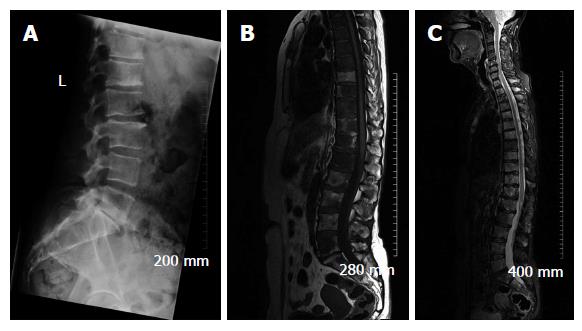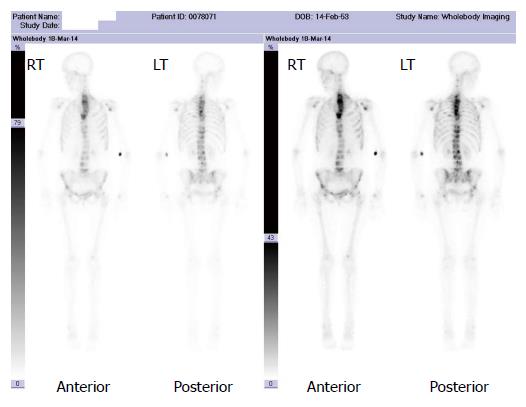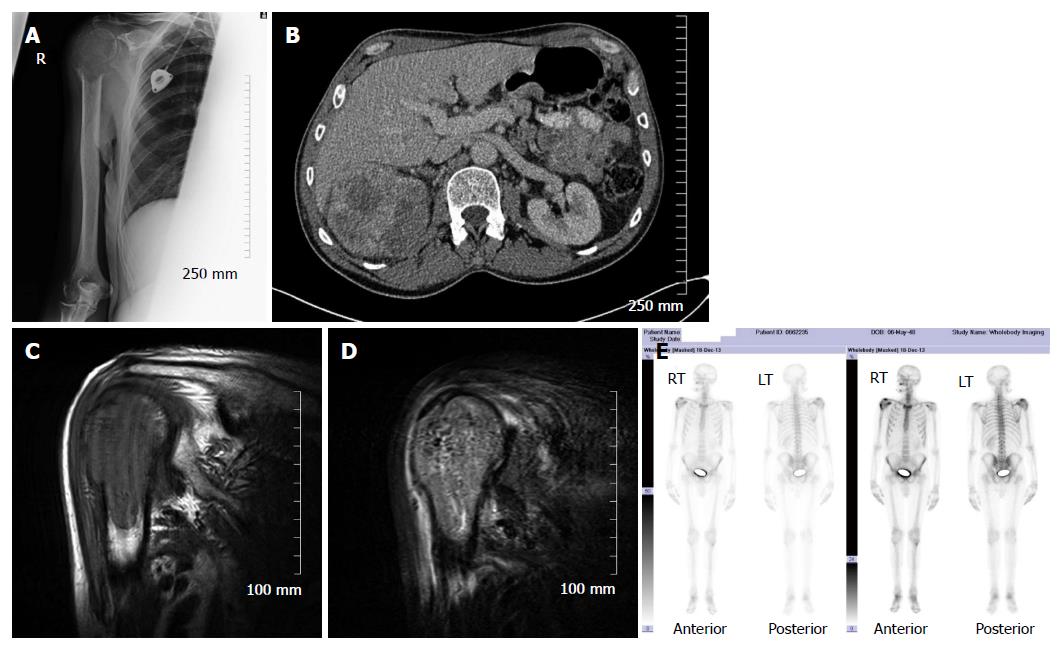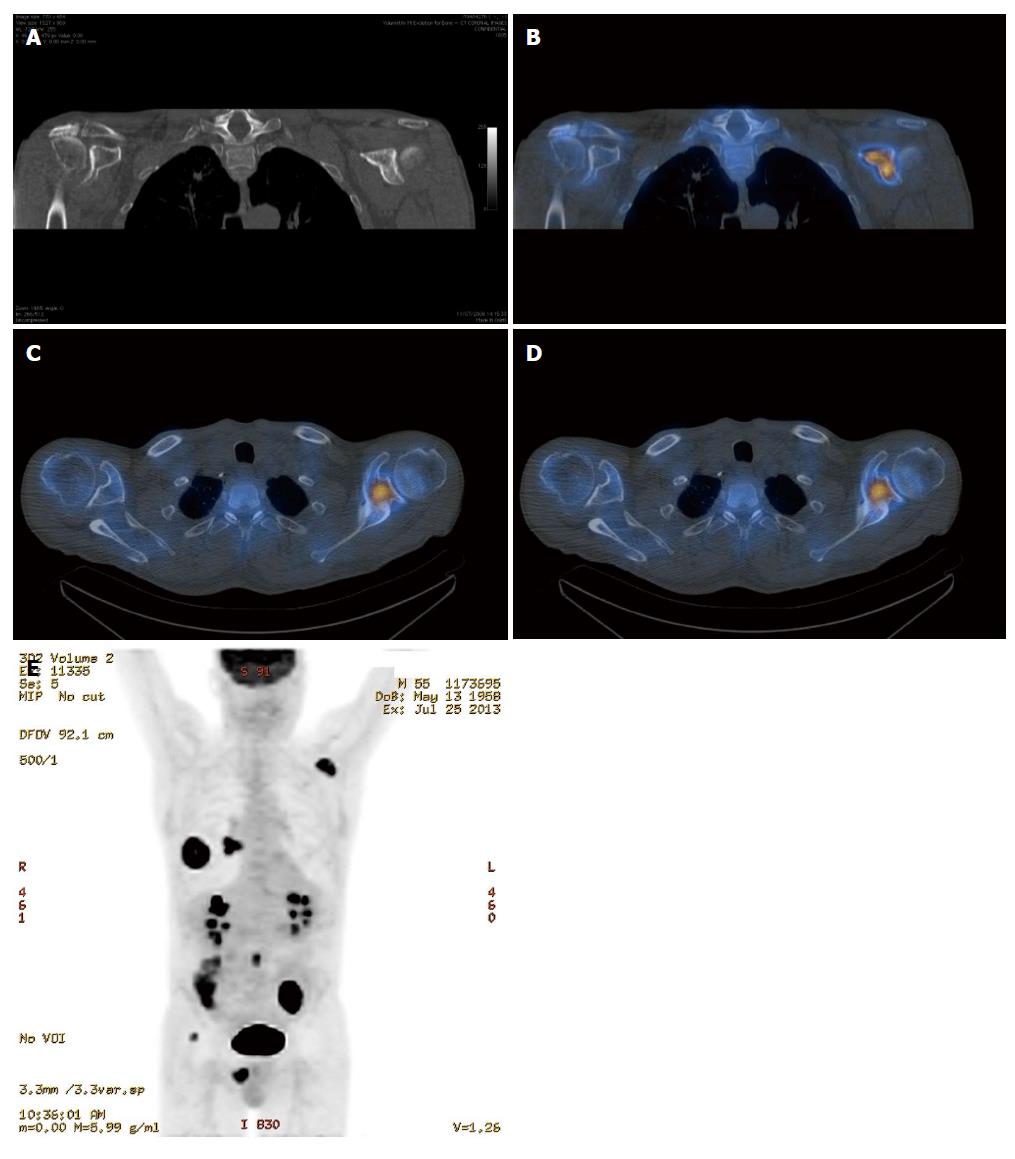Copyright
©The Author(s) 2015.
World J Radiol. Aug 28, 2015; 7(8): 202-211
Published online Aug 28, 2015. doi: 10.4329/wjr.v7.i8.202
Published online Aug 28, 2015. doi: 10.4329/wjr.v7.i8.202
Figure 1 Bone metastasis in the appendicular skeleton is most commonly due to primary lung malignancy.
A: Axial computed tomography image of the upper thorax (soft tissue window) demonstrating a large right upper lobe mass with ipsilateral pulmonary and lymph node metastasis; B and C: PA and lateral views of the right thumb demonstrating a lytic metastatic deposit in the middle phalanx.
Figure 2 Magnetic resonance imaging is superior to plain radiography for detection of bone metastasis.
A: Lateral lumbar spine radiograph demonstrates subtle sclerotic metastatic deposits at the inferior endplate of T12 and L1 from a primary breast malignancy; Sagittal T1 (B) and short tau inversion recovery (STIR) (C) images of the spine acquired one day later demonstrate diffuse bone metastasis (abnormal low T1 and high STIR signal in the bone marrow) which is not evident on the radiograph.
Figure 3 Diffuse bone metastasis on bone scintigraphy.
Abnormal accumulation of radiotracer throughout the spine, most pronounced in the upper thoracic spine with additional pelvic and bilateral rib metastases in a patient with primary breast malignancy. Focal accumulation of radiotracer in the left antecubital fossa represents artefact at the radiotracer injection site.
Figure 4 Lytic bone metastases are poorly demonstrated on bone scintigraphy.
Plain radiograph (A) demonstrating a lytic metastatic deposit in the right proximal humerus in a patient with a large right renal cell carcinoma (B); Corresponding abnormal low T1 and high short tau inversion recovery signal on magnetic resonance imaging (C and D); Only the small osteoblastic component of the metastatic deposit demonstrates abnormal accumulation of radiotracer on bone scintigraphy (E).
Figure 5 Single photon emission computed tomography has higher sensitivity and specificity for detection of bone metastasis when compared with bone scinitigraphy.
A: Abnormal accumulation of radiotracer in the right clavicle on bone scintigraphy in a patient with primary lung malignancy; Axial (B) and coronal (C) single photon emission CT/CT images demonstrate the superior spatial and contrast resolution of this hybrid technique which enables improved detection and characterisation on bone metastases.
Figure 6 Single photon emission emission computed tomography-computed tomography is more sensitive for detection of bone metastasis than computed tomography alone.
A: Coronal CT image of the left scapula (bone window) in a patient with primary lung malignancy does not demonstrate an aggressive bone lesion; Coronal and axial single photon emission CT/CT (B, C) and axial 18F fluorodeoxyglucose-positron emission tomography (FDG-PET)/CT (D) demonstrate abnormal radiotracer accumulation in the left clavicle consistent with bone metastasis; E: Coronal PET maximum intensity projection image demonstrating 18F FDG avid primary lung malignancy and right hilar lymph node metastasis in addition to the metastatic deposit in the left scapula.
- Citation: O’Sullivan GJ, Carty FL, Cronin CG. Imaging of bone metastasis: An update. World J Radiol 2015; 7(8): 202-211
- URL: https://www.wjgnet.com/1949-8470/full/v7/i8/202.htm
- DOI: https://dx.doi.org/10.4329/wjr.v7.i8.202


















